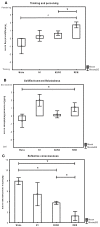Assessing sleep consciousness within subjects using a serial awakening paradigm
- PMID: 23970876
- PMCID: PMC3747360
- DOI: 10.3389/fpsyg.2013.00542
Assessing sleep consciousness within subjects using a serial awakening paradigm
Abstract
Dreaming-a particular form of consciousness that occurs during sleep-undergoes major changes in the course of the night. We aimed to outline state-dependent features of consciousness using a paradigm with multiple serial awakenings/questionings that allowed for within as well as between subject comparisons. Seven healthy participants who spent 44 experimental study nights in the laboratory were awakened by a computerized sound at 15-30 min intervals, regardless of sleep stage, and questioned for the presence or absence of sleep consciousness. Recall without content ("I was experiencing something but do not remember what") was considered separately. Subjects had to indicate the content of the most recent conscious experience prior to the alarm sound and to estimate its duration and richness. We also assessed the degree of thinking and perceiving, self- and environment-relatedness and reflective consciousness of the experiences. Of the 778 questionings, 5% were performed during wakefulness, 2% in stage N1, 42% in N2, 33% in N3, and 17% in rapid eye movement (REM) sleep. Recall with content was reported in 34% of non-REM and in 77% of REM sleep awakenings. Sleep fragmentation inherent to the study design appeared to only minimally affect the recall of conscious experiences. Each stage displayed a unique combination of characteristic features of sleep consciousness. In conclusion, our serial awakening paradigm allowed us to collect a large and representative sample of conscious experiences across states of being. It represents a time-efficient method for the study of sleep consciousness that may prove particularly advantageous when combined with techniques such as functional MRI and high-density EEG.
Keywords: EEG; consciousness; dreaming; sleep; wakefulness.
Figures








References
Grants and funding
LinkOut - more resources
Full Text Sources
Other Literature Sources

